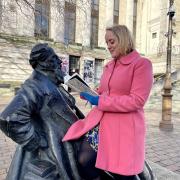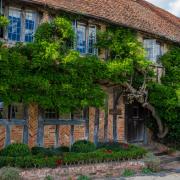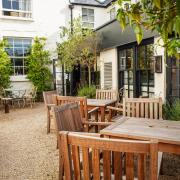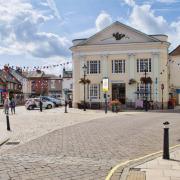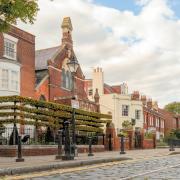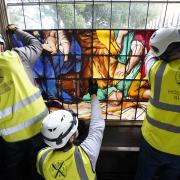A building turned inside out, that’s the Portsmouth Royal Garrison Church whose major restoration shines new light on 800 years of history.
Glancing eyes left whilst walking eastwards along Portsmouth’s Millennium Promenade, the mesmeric pull of a seemingly ruinous yet rooted church, is hard to ignore.
‘People often ask me what makes this site so important and, actually, it’s difficult to choose which one of the historic layers has most significance,’ admits Samantha Stones, senior properties curator for English Heritage who care for Old Portsmouth’s iconic Royal Garrison Church.
‘As a Medieval pilgrim’s hospital and shelter, this would almost be enough in itself. Yet, when you consider that Portsmouth was, in fact, the national garrison, this church is part of that story too. It’s witnessed not just the solders but also their wives and families coming here, lives that can be traced to all parts of the British Empire. It’s a fantastic site.’

The 800-year-old Domus Dei, or God’s House, founded by the Bishop of Winchester had, following the Tudor dissolution of monasteries, served briefly as an armoury before becoming elevated to the city’s Government House and garrison. A venue fit for King Charles II’s 1662 wedding to Catherine, Duchess of Braganza. And, in 1814, a lavish celebration attended by the Prince Regent, the Emperor of Russia, the Duke of Wellington and Marshal Blűcher, to mark the defeat of Napoleon.
Although only the church still stands, a six-year restoration project offers says site manager Ali Naylor, the opportunity to experience its lifecycle in full.
‘What’s amazing is that there’s both an outside and inside space that can be enjoyed.
‘Using a new step-free route at the south porch you enter the nave, the part that was firebombed in 1941 after a device missed the dockyard and hit the church. Although the nave is completely open to the elements, the side aisles are roofed, with benches providing tranquillity.

‘You then go through our newly installed glass partition screen into the chancel which was, almost, undamaged in the bombing. Here, the church is dressed as in the latter part of its life.’
Samantha explains: ‘The whole project centred on the replacement screen within the chancel arch. Making sure the design was appropriate whilst respecting its setting, was key.’
Tasked with advising on changes that could impact this scheduled monument, the striking juxtaposition of new and old mirrors, she says, the ‘light touch’ applied to conservation work.
‘It’s not often that we do such modern interventions. The previous screen, put in around 1966, was constructed of reinforced concrete and beginning to fall apart and to corrode in the harsh marine environment.’
Itself a replacement for a post-war wooden installation, both screens were purely functional to keep the best-preserved part of the church watertight. However, despite no requirement to structurally support the arch, visually this barrier split the church into disparate parts.
Now, the intact chancel’s glorious stained east window floods the whole area with light, thanks to the newly fabricated floor to ceiling glass wall with its simple bronze frame. The two reconnected spaces, completely transformed.
Describing the project as, ‘incredibly technically complex,’ and necessitating multiple surveys, Samantha applauds the heritage architects, structural engineers, façade engineers and in-house conservation specialists involved.

‘We looked at what would work in the space and the most appropriate materials.
‘The screen had to be strong as it’s so high. We also had to avoid the archaeology as there’s a burial vault immediately below. Minimising fixings to the masonry was also important; my heart was in my mouth as these were being drilled.
Adding: ‘Having carried out paint sampling, the 1980’s decorated peach-coloured walls have been taken back to off-white, which would have been found in both Medieval and Victorian churches.’
With the chancel celebrating the 19th century makeover designed by George Edmund Street, collections conservator Sophie Downes knows first-hand the damage that ultraviolet light, can inflict. For her, stabilising the collection was challenging yet hugely rewarding.
‘The replacement of the screen meant that as well as dust there was a risk from all of the conditions – temperature, light, and humidity – which we don’t really like when it comes to conserving collections.

‘So, all of the 21 regimental banners that hang from decorative poles, and all of the removable pew items, chairs, and metal objects were removed. The first of these came out in November 2001 with the rest by the time building works properly started at Easter 2022. They all had a clean, and the brass had a polish.’
Unable to re-stitch the delicate silk banners, Sophie used her professional expertise to reinforce these using special adhesive net. Another conservator renovating the intricate alter frontal. Whilst the Mallorcan floor tiles can just be seen, peeping out from under a protective carpet covering.
There’s so much to marvel at, with the added bonus of now being able to take a pew, including sitting on those charred by the firebombing. From where there’s a chance to admire the towering organ pipes which sparkle afresh, having had shrapnel damage to their Victorian fretwork repaired.
According to Sophie: ‘It was lovely to be able to commission the craftspeople to work sympathetically on these objects. In particular, the restored pews and organ pipes which the former Friends group fundraised towards.’
Leaving a legacy for all to see, the Friends have handed over the day-to-day opening of the church to a knowledgeable team of volunteers.
‘A lot of people still have a connection with the church,’ says Ali Naylor. ‘It’s a really important part of the Old Portsmouth community. One of our volunteer’s mothers was christened here, so she’s carrying on her own story.
‘We’ve also been working with the University of Southampton, looking at the graves to identify who these people are and where they once lived. The idea is to put together a map of local homes.’
And, whether joining forces with local schools and the nearby Portsmouth Cathedral, or staging Pilates and lattes on the south field, this building has certainly dusted itself off.
As rising phoenix-like from the ashes, a new chapter in the illustrious history of Portsmouth’s Royal Garrison Church begins.
Pay a visit
Where: Portsmouth Royal Garrison Church, Penny Street, Portsmouth, PO1 2NJ
When: Open Thursday, Friday, Saturday, 11am-4pm until the end of October. Reopens April.
How: Free admission; wheelchair accessible; assistance dogs only. Car parking nearby.
Also worth a visit
Portsmouth: King James’s & Landport Gate
Oldest of the fortified city’s two surviving gateways, is King James’s Gate. Constructed on Charles II’s orders atop earlier ramparts, in the early 20th century it was re-sited to Burnaby Road. Landport Gate, once Portsmouth’s main entrance, is attributed to Nicholas Hawksmoor c.1760.
Netley Abbey
Overlooking Southampton Water, Netley Abbey founded in 1238 by the Bishop of Winchester Peter des Roches is Southern England’s most complete Cistercian monastery. Reflecting eight centuries of change, the Abbey was converted into a fashionable Tudor house and provided the inspiration for Jane Austin’s novel Northanger Abbey.
Winchester: Wolvesey Old Bishop’s Palace
A stone’s throw from Winchester Cathedral, the 12th century former palace of Bishop Henry of Blois is a reminder of the power of the Medieval clergy. In 1554 Wolvesey Palace hosted the wedding banquet of Queen Mary and Philip of Spain.
Titchfield Abbey
Converted by Sir Thomas Wriothesley, Earl of Southampton, from a 13th century building for Premonstratensian canons into Palace House, a turreted gatehouse across the nave remains an impressive feature.




